
by Russ McSpadden / Earth First! News
The first time I ever saw a drone I was sweating my ass off, hiking jugs of water through a cactus forest to drop in remote canyons for famished migrants making the deadly trek through the Sonoran desert. U.S. Customs and Border Protection surveillance drones patrol the skies along the border with Mexico on the daily. Like any good activist I gave the drone the bird and then quickly ducked beneath a cholla, which I don’t advise doing, as it is a cactus with a reputation.

Two 10,000-pound Predator-B border patrol drones. These are the fellas that patrol the borderlands, from Yuma, Ariz., to Brownsville, Tex.
Since his inauguration, noble peace prize winning president Barack Obama has increased the U.S. military’s use of drones and rewritten the rules of engagement in over a dozen countries around the world. Hundreds of civilians, including swaths of children and several dozen Al Qaeda operatives have been eviscerated by remote. Even four U.S. citizens have been assassinated by drones, violating due process and habeas corpus protections in the U.S. constitution. Reports put the ratio of civilians to “suspected terrorists” killed by drone strikes at about 50 to 1, meaning roughly 98% of the deaths are “collateral damage.”
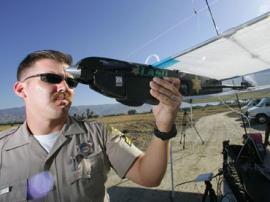
When the awful power of cop mustaches and surveillance drones unite, we all lose.
In the domestic scene, sheriffs’ departments of dozens of municipalities across the U.S. are already using drones for surveillance and hundreds more are seeking approval for their use. If you haven’t seen a drone outside of CNN, don’t worry, you will. The Orlando sheriff’s department is currently awaiting permission to use drones over Disney, the privacy rights of Goofy be damned. And New York City’s Mayor Bloomberg has called drones an “inevitability” in the Big Apple, saying “It’s not a question of whether it’s good or bad. I just don’t see how you can stop them.” Somehow I get the feeling the mayor said that under duress, as in, there was a drone standing behind him holding a gun to his head.
There are even those that would see drones used by wildlife officials to track and kill “problem” predators. In a 2011 L.A. Times article, Montana’s Democratic Senator Max Baucus is quoted cheerleading for drone use in that state’s war on wild wolves. Wait, wolves hunted down by robots from the sky? There are even autonomous pet drones that follow their owner around, like a puppy, and record their every move, like a fucking spook. And then there are the self-proclaimed anarchist beekeepers that claim to have downed a media drone in the U.S with, well, angry honey bees. Oh damn. This drone shit is a very, very serious matter.
Thus I offer this drone demonology, detailing some of the more fascinating, confusing and terrifying political, technical and cultural manifestations of drones in our world.
The Tragicomedy of Drone Pilots, Nintendo and Death from Distant Joysticks:

According to some drone pilots, “down down up up down up left right B A select start” is a really great infinite lives cheat that works battle. Others, however, argue that it is actually a secret CIA guide for appropriate masturbation techniques dating back to the late 1960s.
Lets keep things honest and sadly humorous for a moment. Drone technologies rely on a cultural laziness inherent in the first world. Graphically magical mass media technologies, from scoping out your travel destination with a drones-eye-view on Google Earth to sitting for hours with an Xbox, gorging on the blood-splatter of zombies, terrorists and other enemies-of-the-state through first person shooters, are a national past time in the Western dominated world. When I was a kid I loved to play F-15 Strike Eagle on my 8-bit NES and I used to pretend that I was controlling a real fighter jet that was actually out there in real combat. It was an obvious fantasy and premonition for a boy reared as I was on mac-and-cheese and GI Joe. I’d drink Dr. Thunder, eat Fritos and bag Libyan jets left and right, a 9-year-old Lieutenant Pete “Maverick” Mitchell in training. Had I maintained my childhood imperial innocence, well hell, current military technologies could have turned my boring and lazy boyhood dreams into a boring, lazy and murderous reality. The spoof documentary of the lives of drone pilots from Comedy Central below is a rather genius reading of the evolution of our lazy high-tech gamer culture into an all to real, cybernetic empire of comfy chair-bound assassins:
The U.S. has an ever increasing corps of cyber-warriors and drone pilots — the men and women behind the machines — and there has been much debate in the halls of power on how best to utilize, honor or ridicule them.
Back in February of this year, Defense Secretary Leon Panetta approved the military’s first new combat medal in nearly a century, which was to be given to drone pilots. The Distinguished Warfare Medal was created to recognize the “extraordinary contributions” drone pilots provide to combat operations conducted from afar. The new medal caused an outrage. In the military hierarchy of honor, the drone medal became the eighth highest award behind the Medal of Honor and ahead of the Purple Heart. A coalition of veterans groups and politicians spent months protesting and lobbying the Pentagon and President Obama to downgrade the award, calling it “the Chair-borne Medal,” “the Nintendo Medal,” “the Purple Buttocks,” and the “Distant Warfare Medal,” demeaning the computer-based iWarriors because they are not exposed to imminent mortal danger like traditional combat soldiers.

While this is a spoof image of the medal you can see the design of the real one here.
In April the medal was revoked by the new Defense Secretary Chuck Hagel. During the kerfuffle little debate was put forward questioning the ethics of bestowing an honorary trinket on a group of techno-bombadiers that spy on and strike with such deadly and impersonal results from the comfort of a computer screen.
I think it is actually a promising sign for humanity that, according to researchers at the Department of Defense, drone pilots actually experience many of the same battlefield traumas, and at the same rate, as pilots of manned aircraft deployed in combat. “Mental health problems” such as PTSD, depression and anxiety are most likely a healthy response to the taking of lives, the bombing of schools, weddings or even militant tribal camps, and perhaps especially because of the level of disassociation and anonymity involved. Just as one might feel pretty empty following a session of computer generated virtual sex, computer generated virtual killing, which results in real life killing, must stab at the soul’s need for authenticity and love in its own f-ed up way. Likewise, many drone pilots are not deployed abroad but rather engage in combat from the U.S. and return to their “normal” lives, to their families and homes, at the end each day. Separated from the tight-knit and effective military camaraderie of the killing culture of the front-lines, drone pilots are left to psychologically balance their domestic world with their bombing missions on a daily bases.
As a recruiting tool for teenagers, the Air Force even offers a series of video games on its website, one of which allows you to “fly the MQ-9 Reaper” drone, an online game allowing kids to rain missiles down on buildings in a generic desert environment, created at taxpayer expense.
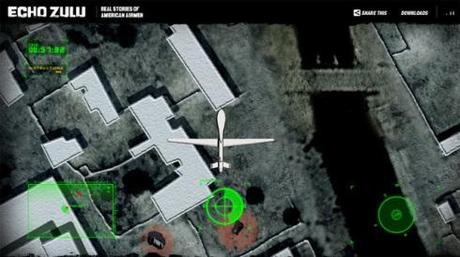
“Mesmerized by approaching calamity, we could only stare in abject horror as the silent missile bore down upon them out of the sky.… When the screens cleared, I saw the bicycle blown 20 feet away. One of the tires was still spinning. The bodies of the two little boys lay bent and broken among the bodies of the insurgents.” — a drone pilot quoted in book Drone Warfare
A Drone By Any Other Name Would Still Smell Like Death [Warning, word etymology coming up]
I once received a rather belligerent response to a rather belligerent comment I posted beneath an online article about military drones which went,
“Hey Rusty, 1) you are a total idot [sic]. Drones are not robots and in fact, these aren’t even drones. They are unmanned arial [sic] vehicles UAVs. Drones are just radio controlled machines that have a human flying them. My kid has a drone he got at Walgreens for $35. UAVs though have some sophistication and even some level of autonomy through advanced inboard military technologies. 2) Some UAVs are robots.”
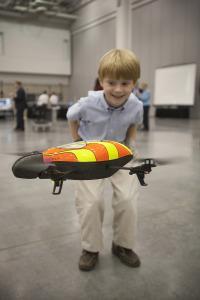
The Parrot flying AR Drone that can be flown using an iPhone or iPad captivates young and old, cushioning the “future shock” that will come when these fuckers are swarming your downtown area, probably spying on your shopping habits and then tagging a photo of you purchasing a cardigan or throwing a brick through a bank window on Facebook. You don’t want to be “unfriended” by a drone.
I actually gleaned a great deal of useful knowledge from PatriotSlimJob911′s comment. It is important to parse words when it comes to topics of great import. “Drone,” “UAV” and “Robot” are not necessarily interchangeable and probably not even sufficient to convey the variety and complexity of drone technologies. A military grade prototype, whether for combat or surveillance on the global battlefield, will be far different from police models used to quell domestic dissent or a corporate model meant for news companies, private security, advertising agencies, NGOs and personal use. Each one promises to suck for quite different reasons. So lets parse words, discuss various models and uses, and get down to etymology and history, shall we?
According to etymologists, the word drone comes originally from Old English dran or dræn meaning a male honeybee but also had a diminutive and figurative meaning by the 15th-century meaning “idler, lazy worker” as male honey bees don’t make honey, and an imitative usage by the 16th-century meaning a “deep, continuous humming sound” like the droning sound bees, planes and, um, drones make. It wasn’t, however, until 1946 that the term took on the meaning “pilotless aircraft” which first appeared in print in an article in the November issue of Popular Science:
Drones, as the radio-controlled craft are called, have many potentialities, civilian and military. Some day huge mother ships may guide fleets of long-distance, cargo-carrying airplanes across continents and oceans. Long-range drones armed with atomic bombs could be flown by accompanying mother ships to their targets and in for perfect hits.
At the time, the U.S. had just dropped atomic bombs on two cities in Japan, eviscerating over 100,000 civilians almost instantly and leaving another 100,00 or more to die painfully tortured deaths from radiation sickness over the coming years. Germany was defeated in the Eastern theater of WWII a few years earlier and the Soviets were looking like the next enemies of freedom.
For their part, the military has never really called them drones, which is the popular, some might say, amateur term. No, the military prefers to call them unmanned aerial vehicles (UAVs) because, well, those cigar chopping f*ckers love a good acronym. They used to call them remotely piloted vehicles (RVPs) but, following the development of more sophisticated technology, which changed the level of human involvement, they saw it fit to upgrade the acronym. Many UAVs have preprogrammed flight plans, meaning they basically fly themselves and have some level of autonomy. The computer on the craft can even “react” to changing conditions. RVPs were literally flown by remote-control.
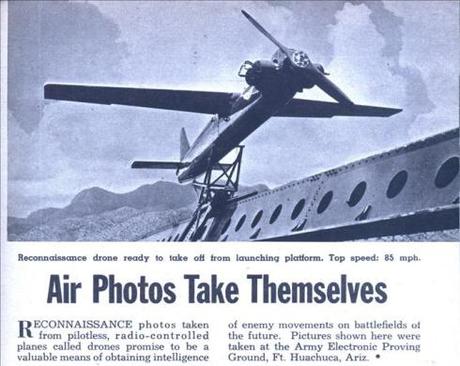
From the March 1956 issue of Mechanix Illustrated. The photo was taken at the Army Electronic Proving Ground, Ft. Huachuca, Ariz.
PatriotSlimJob911, probably considers himself a bit of a word purist patriot, thus his stance on the term UAV for military grade versions and drone for toys, but they are actually interchangeable terms, both describing an aircraft without a human pilot on board. As is probably obvious, I’m going with the popular term. [Touché PatriotSlimJob, I await your comments below!] But call them UAVs, RAV’s, flying robots or late for dinner, drones have been a part of the war machine since well before 1946.
The Good Ole Days of Drones [Warning, brief but gratuitous military history coming up]

That’s Low, at center front, surrounded by a crew of other sour faced chaps of the Experimental Works staff of the Royal Flying Corps.
Perhaps the first drone prototype ever created, clumsy as it happened to be, was the “Aerial Target” created in 1916 by Archibald Montgomery Low, an English engineer and inventor. Low was commissioned by the British Royal Flying Corps, predecessor to the Royal Air Force, to follow through with his civilian research to create a remotely controlled aircraft, which the Brits wanted to use as a kind of guided missile against the Germans in WWI. While Low proved that he could successfully launch and, at least temporarily, steer the first ever military drone prototype, actual flights never went far, crashing shortly after take-off. Low’s system’s however were later adapted by various other British military programs, leading to the Larynx “long range gun with lynx engine”, another human controlled aircraft strapped with explosives that the British tinkered with unsuccessfully between 1925 and into the 1940s. Subsequently, the Nazi regime in German picked up on Low’s remote-controlled guidance system for their highly effective and deadly V-1 flying bombs that terrorized the civilian populations of London during the Second World War.

Cutaway drawing of a V-1 flying bomb showing fuel cells, warhead and other equipment.
The United States entered the drone market in full speed after WWII. There is the Teledyne Ryan Firebee, unveiled in 1951 in response to a request by the U.S. Air Force for an unmanned gunnery target. Israel used a slew of Firebees during the 1973 Yom Kippur War to prod Egypt into wasting its arsenal of anti-aircraft missiles. Israeli pilots then invaded a nearly defenseless Egyptian air space. Firebees were the first drones outfitted with a jet engine, followed by the Beechcraft Model 1001, created for the U.S. Navy in ’55. But these things, like their predecessors, were not autonomous. They were manually piloted.

Here is the Teledyne Ryan Firebee drone looking like a much more dapper version of its Nazi predecessor. This photo was taken at Muzeyon Heyl ha-Avir, Hatzerim airbase, Israel.
During a U.S. State House Committee on Appropriations meeting on February 26, 1973, a military official confirmed that drones had been in operation for sometime in Vietnam. According to the book Fireflies and Other UAVs by military historian William Wagner, the USAF 100th Strategic Reconnaissance Wing flew roughly 3,500 drone missions during the war. In the book, Air Force General John C. Meyer noted that “we let the drone do the high-risk flying…the loss rate is high, but we are willing to risk more of them…” Some 554 drones were either shot down or crashed by other means during sorties against the Vietcong and the North Vietnamese. Apparently, the Chinese published photos of several downed drones in the 1970s but I haven’t been able to find them.
Israel may be the first state to have developed the modern drone — equipped with thrust vectoring control systems, inboard navigation, live video transmission and 360-degree surveillance technologies — that proved successful in defeating the Syrian air force at the beginning of the 1982 Lebanon War. For those geeks out there that want to know more about the tech specs, check out Benjamin Gal-Or’s highly important and sure-fire snooze-fest of a book Vectored Propulsion, Supermaneuverability & Robot Aircraft.
A whole bunch of shit probably happened during the 1980s to propel drone technology along. I’m actually bored myself with this military history. Suffice to say, information age advancements, many of which you probably use on the daily, may very well be the sloppy seconds of drone projects. During the ’90s, the U.S. Department of Defense contracted the U.S. based AAI Corporation and the Israeli company Mazlat to create a next generation drone. The two company’s worked together and came up with the Pioneer, which was used in the 1991 Gulf War and is still being used today as a surveillance drone.
Its the General Atomics MQ-1 Reaper, aka the Predator, however, that we all tend to think about when we think of drones, especially those of the armed variety. The predator is strapped with Hellfire missiles and has been known to blast schools, hospitals and, from time to time, Al Qaeda militants at the behest of the Obama Administration, the military and the CIA.

This is the MQ-9 REAPER (Predator), the nightmare drone you are most likely to read about. It runs on a flex-fuel mixture of freedom, gasoline and the blood of the innocent.
Today there are shit tons of drone types out there. A 2013 National Geographic exposé on drones reported that more than 50 countries are packing flying robots. Iran, China and a few other nations even make their own.
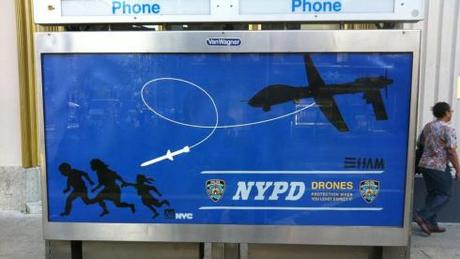
Can I Have My Own Drone If I Promise to Feed and Care for It?
Everyday, you and your friends upload videos, photos and status updates about your personal lives on Facebook and other social media. As a culture we’ve grown accustomed to providing intimate documentation to friends, friends of friends, and inadvertently, companies that collect data on consumer habits, private security firms that track activists and of course, as Edward Snowden has taught us all, no-longer-secret secret government spy centers. We are a social species and our posts are surely benign in intention. Yet how far will we go? Well, you can purchase a pet drone. Going for a hike in the Redwoods or shooting fire crackers at your friend’s ass and want that memory to go viral online? Falkor Systems will provide you with a creepy flying robot to follow you around 24/7 and upload your life:
a
How Can I Protect Myself From Drones, I Mean, Pssst, Can I Get What I Need To Shoot One Down, Hypothetically Speaking, at WalMart
 Whether you want to protect yourself from drones or engage in a full-on resistance movement in the forthcoming robot wars, you will find it hard to combat military grade surveillance and combat bots. They fly high, can be strapped with missiles, cameras and sensors that can see through walls, and even artificial intelligence. DARPA, perhaps the creepiest government agency out there, is currently producing machine-based visual intelligence for drones. This means they can pick up visual nuance, much like a bipedal government agent, in the way you move and interact, and then interpret those movements as benign or suspicious. They call it Minds Eye. So there is that.
Whether you want to protect yourself from drones or engage in a full-on resistance movement in the forthcoming robot wars, you will find it hard to combat military grade surveillance and combat bots. They fly high, can be strapped with missiles, cameras and sensors that can see through walls, and even artificial intelligence. DARPA, perhaps the creepiest government agency out there, is currently producing machine-based visual intelligence for drones. This means they can pick up visual nuance, much like a bipedal government agent, in the way you move and interact, and then interpret those movements as benign or suspicious. They call it Minds Eye. So there is that.
There is a company called Domestic Drone Countermeasures based in Oregon that for about the price of a new car will sell you equipment that can neutralize sound and image capabilities of a drone near you. Of course the company is a spin-off from another company that sells technologies to the Defense Department and its hard to imagine a corporate fix to your drone problems.

The anti-drone hoodie is so fashionable you’ll wish drones could see you.
There is also an anti-drone hoodie that hides its wearer from the thermal imaging systems of drones. The tin-foil of our times, it could very well become a hipster fashion worn ironically while walking one’s pet drone around Portland.
If that doesn’t work you can try training honey bees to attack drones as an anonymous group of self-proclaimed anarchist beekeepers claim to have done in this video below. In the video you see a swarm of bees attack a helicopter style drone from the drone’s camera view. At the end of the video you’ll see the grounded drone, which does look like a kids remote control helicopter:
a
If all else fails, you might glean a bit of knowledge from a 22-step handbook on drone evasion left behind by Islamist militants in Timbuktu. Some of the pertinent details are below:
- It is possible to know the intention and the mission of the drone by using the Russianmade “sky grabber” device to infiltrate the drone’s waves and the frequencies. The device is available in the market for $2,595 and the one who operates it should be a computer know-how.
- Using devices that broadcast frequencies or pack of frequencies to disconnect the contacts and confuse the frequencies used to control the drone. The Mujahideen have had successful experiments using the Russian-made “Racal.”
- Spreading the reflective pieces of glass on a car or on the roof of the building.
- Placing a group of skilled snipers to hunt the drone, especially the reconnaissance ones because they fly low, about six kilometers or less.
- Jamming of and confusing of electronic communication using the ordinary water-lifting dynamo fitted with a 30-meter copper pole.
- Jamming of and confusing of electronic communication using old equipment and keeping them 24-hour running because of their strong frequencies and it is possible using simple ideas of deception of equipment to attract the electronic waves devices similar to that used by the Yugoslav army when they used the microwave (oven) in attracting and confusing the NATO missiles fitted with electromagnetic searching devices.
- Using general confusion methods and not to use permanent headquarters.
- Discovering the presence of a drone through well-placed reconnaissance networks and to warn all the formations to halt any movement in the area.
- To hide from being directly or indirectly spotted, especially at night.
- To hide under thick trees because they are the best cover against the planes.
- To stay in places unlit by the sun such as the shadows of the buildings or the trees.
- Maintain complete silence of all wireless contacts.
- Disembark of vehicles and keep away from them especially when being chased or during combat.
- To deceive the drone by entering places of multiple entrances and exits.
- Using underground shelters because the missiles fired by these planes are usually of the fragmented anti-personnel and not anti-buildings type.
- To avoid gathering in open areas and in urgent cases, use building of multiple doors or exits.
- Forming anti-spies groups to look for spies and agents.
- Formation of fake gatherings such as using dolls and statutes to be placed outside false ditches to mislead the enemy.
- When discovering that a drone is after a car, leave the car immediately and everyone should go in different direction because the planes are unable to get after everyone.
- Using natural barricades like forests and caves when there is an urgent need for training or gathering.
- In frequently targeted areas, use smoke as cover by burning tires.
- As for the leaders or those sought after, they should not use communications equipment because the enemy usually keeps a voice tag through which they can identify the speaking person and then locate him.
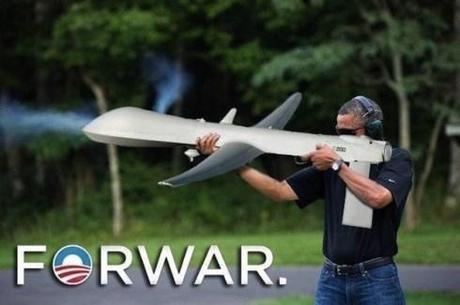
Be sure to stay tuned for Part VI of the Early History of the Robot Wars and check out Part I and Part II and Part III and Part IV to catch up on twitter controlled cyborgs, sext messages in your eyeballs and other totally true techno-creepy shit.

